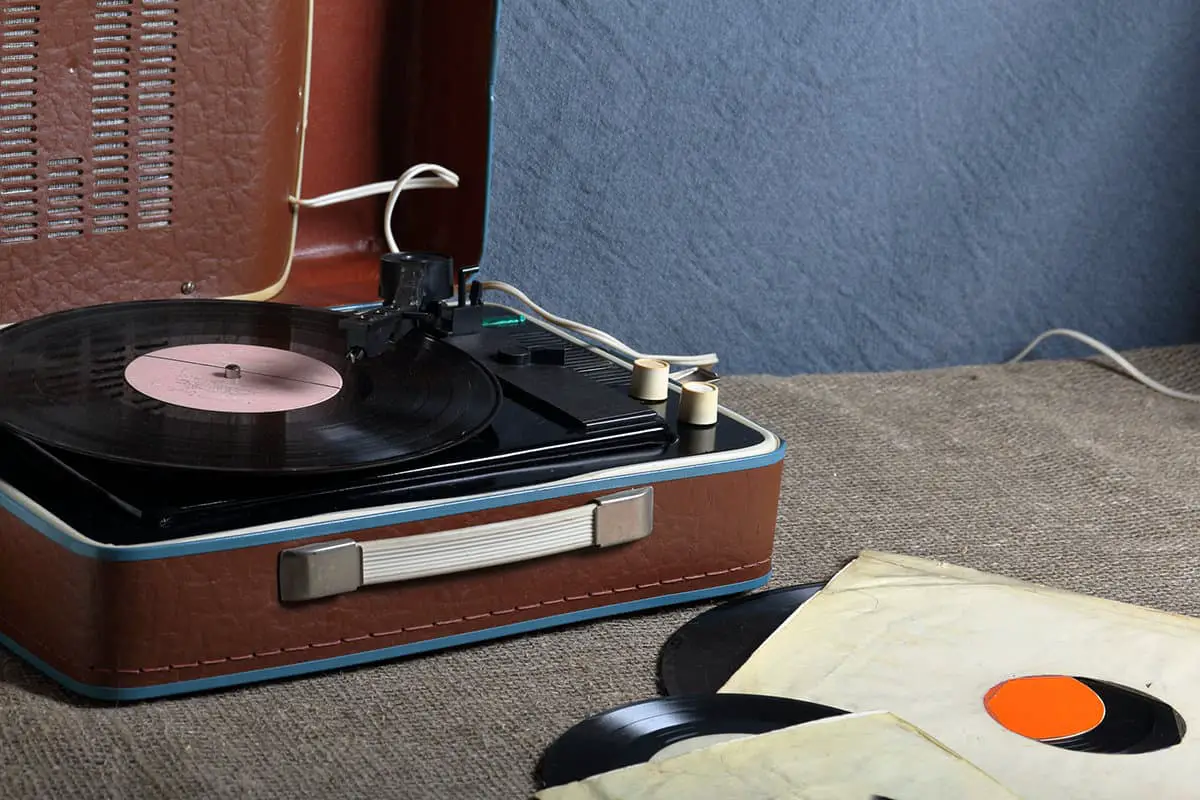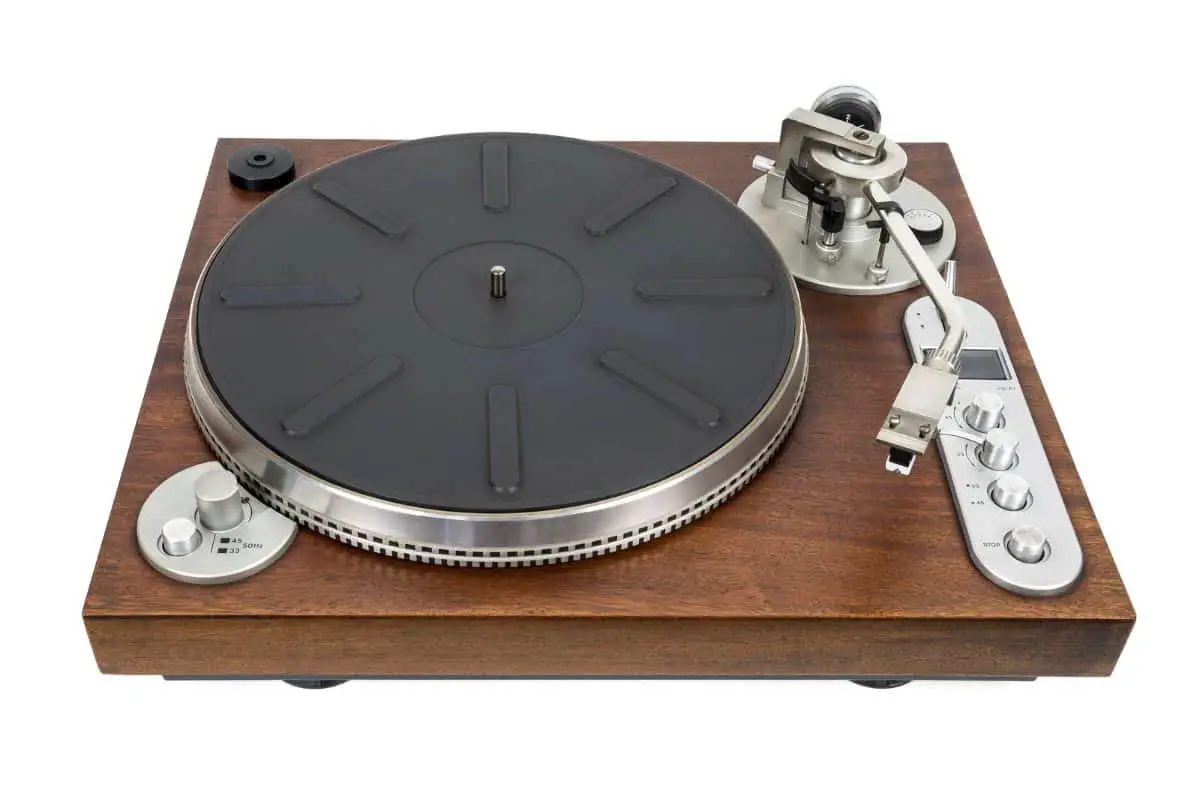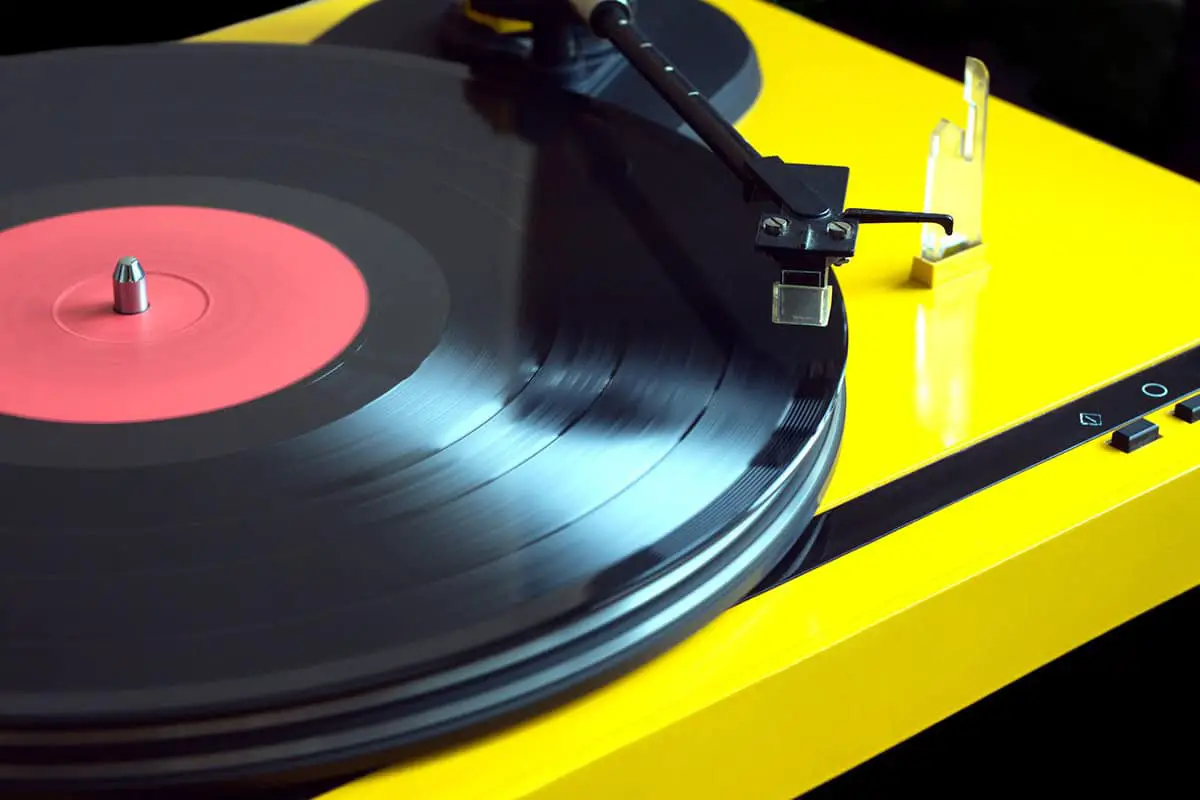This post contains affiliate links.

Can a turntable be used as a record player? This article explores the differences between both devices and the possibility of using one instead of another.
You can use a turntable like a record player. The difference in both devices has to do with their functions and not necessarily the quality of sound produced.
Evidently, a record player needs a turntable to operate. The same also goes for the turntable in the same light, which requires a couple of additional pieces of equipment to function as a record player.
Table of Contents
What Is A Turntable?
A turntable is a significant part of a record player. It is the part of the record player that holds the record and spins it.
A turntable can also be a standalone device modeled to play records and transmit the signal to your speaker for amplification. The core components of a turntable are as outlined:
- A plinth, which is the base of the turntable.
- A platter, which is the spinning part.
- A stylus, tonearm, and cartridge. These parts track and read the record.
Since most turntable models do not have built-in speakers, you will have to connect the turntable to an amplifier or receiver to boost the sound before it can be transmitted loudly through speakers.
You will also require a phono preamp to read the signal from the turntable and then send it to the amplifier.
To simplify this, the stylus, also called the needle, runs in the grooves of the record, reading and transmitting the vibrations through wires found in the tonearm to the cartridge.
The cartridge then reads that information and sends it to the phono preamp, turning it into sound through an external amplifier and then the speaker. The tonearm is the component that also holds the cartridge and stylus in place. (Source)
In order to function effectively as a record player, a turntable will generally require external components for you to use them. It also affords you flexibility and range as you can endlessly customize and go for high-end external components.
Benefits Of Owning A Turntable
Superior Sound Quality
While not every turntable is worth purchasing, some high-quality turntable models are explicitly designed to play vinyl records. You get what you pay for with a turntable when it comes down to quality.
Adjustable
A turntable comes with adjustable settings such as an anti-skate, tracking speed, and balance weights that you can fine-tune. Turntables are most preferred and exclusively used by electronic music lovers and DJs or hip-hop artists. (Source)
Easy To Upgrade
Ownership of a turntable is perfect for you for music lovers who like to build and tweak their sound systems and improve their sound setup.
You can easily purchase replacement parts for the cartridge, needle, or tonearm. You can also upgrade with various external components of superior quality.
Uniqueness
Because you can customize and fine-tune your turntable with the best components that suit your taste, it means that the possibility of having the same setup as others is reduced.
Each turntable user can build their device into precisely what is pleasing aesthetics and sound quality-wise.
Disadvantages of Turntables
Complicated
Since you can purchase and build your turntable your preferred way, getting help with a difficulty or problem might be difficult, especially if you have to look online for a self-fix.
Maintenance And Upkeep
While maintaining your turntable might not be as frequent given that you follow the care guide and keep the turntable as clean as possible, you could have to deal with changing the components, primarily if you use the turntable frequently. Components like a belt or direct drive, depending on your turntable uses, and a cartridge will need to be oiled or replaced.
Expensive
Turntable units are generally more expensive than a record player unit, which doesn’t include the additional external components such as the phono preamp and speakers.
What is a Phono Preamp?
A phono preamp is an audio component that executes two main functions. The first function is to amplify the signal level from the turntable up to a certain level suitable for the standard receiver input on your system.
The second function performed by the phono preamp is to apply the industry-approved and standard equalization curve RIAA (Recording Industry Association of America) to change the standard frequency adjustment recorded during the record cutting process. (Source)
A phono preamp is pretty essential for a turntable; why? The signal produced by a turntable is feeble and much lower than the standard “line-level signal” made by other audio equipment generally.
Bass frequencies are also reduced in cut records while the high frequencies boost. This equalization performed by the phono preamp helps to allow a much longer recording time by keeping the groove dimensions small. It also increases sound quality and decreases record wear.
Some turntable models come with a built-in phono preamp. At the same time, most will require you to buy an external phono preamp or connecting cables to connect the phono preamp built into your amplifier or receiver.
Related articles:
- Tube Phono Preamp FAQ and Recommendations for Any Budget
- What is a Turntable Phono Preamp? We Explain
What Is A Record Player?
A record player is a device that comes with all the required components to playback and to listen to records on a single device.
All the components, such as the turntable, the preamp, the amplifier, and the speakers, are all housed in a single unit. (source)
The record player is usually much more elaborate than a turntable and comes with several additional features, such as the possibility of playing other audio formats like an MP3.
When dealing with a record player, the main disadvantage is its size. Record players are commonly heavier and larger than turntables, making them less portable.
That’s why record players stay inside the house in a dedicated area or a home entertainment section.
Record players are also more expensive than turntables. Now, because of all the additional components they come with, there is a high risk of lower quality components instead of buying external components like with the turntable.
The main benefit you’re paying for when purchasing a turntable is convenience. The fact that you don’t need to get any additional components makes it the most preferred choice, especially for vinyl newbies who tend to lean more towards aesthetics than sound quality.
Benefits of getting a record player

Portability
Since a record player is an all-in-one unit, they are usually very easy to move and transport around instead of the turntable with multiple heavy components.
Budget-Friendly
There are record player models that sell for as low as $60. You also don’t have to spend extra fees on additional components.
Style
The aesthetically pleasing look of the record player makes it the most preferred for most record lovers.
Extra Functionality
Modern record players commonly have added functionality such as phone charging ports, MP3 players, Bluetooth speakers, CD players, and Radio.
Disadvantages of Record Players
Zero Upgrade Potential
For people who love to build and tweak electronic devices, or commonly enjoy improving your vinyl setup, then the record player is not for you.
Since all the components come pre-built into a single unit, you don’t have the luxury of building what you want.
Lower Sound Quality
Record players have been associated with producing a lower quality of sound when compared to turntables. It is mainly because most components are of lower quality and cannot be changed.
Record Damage
Record players have been commonly associated with adding unwanted and unnecessary wear and tear to vinyl records over some time. It is because the record player is less calibrated than the turntables.
Turntable Vs. Record Player: Which is Better?
There are pros and cons to getting each device, and the answer to this question largely depends on your primary intentions. Would you rather go with premium sound quality, or would you prefer aesthetics?
Most sound-oriented lovers would go with the turntable, while vinyl newbies or record lovers who don’t care would choose a record player. The main deal-breaker is, of course, the performance and sound quality.
But with most sound systems or equipment, the more you can build, the better sound production you get. You have to find a way to balance portability, price, sound quality, and aesthetics.
However, when it comes to making a choice, A good and quality turntable will perform way better in the three core areas of sound quality, record wear, and build quality.
Build Quality
Some record player brands, such as Victrola and Crosley, design and manufacture some all-in-one record player models that include built-in speakers.
Often, these models come with a highly appealing retro aesthetic, which targets the budget-conscious and affordable end of the market.
Thus they do not have the same component and build rating and quality as a cheap turntable.
Record Wear
When it comes to preventing wear and tear on the record, most record players lack the same attention to detail commonly noticed in a turntable regarding tonearm alignment, performance, and tracking force.
These components and settings come pre-set from the factory by design and are not user-adjustable in most cases.
A stylus that isn’t correctly tracking the record groove will wear faster than it would typically, risking audio quality degradation to the record.
Sound Quality
Every single component of an audio system ultimately affects its final sound quality. When it comes to vinyl records, correctly tracking the record groove is highly instrumental to the quality of sound it will produce.
No matter what type of external component you own, it will not boost a poor signal caused by poor tracking.
With a record player, you are paying for convenience, portability, and a fixed design that you can’t upgrade when the situation warrants.
You can change out the cartridge or other components with a turntable for a better and higher-quality part. You also get to make the better and superior choice for speakers.
Budget
For vinyl-loving newbies, a record player is generally a cheaper and preferred option to getting started since they are built to go and don’t require extra components.
Most record player models are also super affordable and aesthetically pleasing to make up for features they lack.
Can Your Turntable Double As A Record Player?
Yes, your turntable can double as a record player. To get this done, all you need to do is purchase the best sets of additional external components required to help produce and transmit premium quality sound.
However, it would be best to consider that your turntable doubling as a record player means you have to give up mobility.
The additional pieces of equipment are usually bulky (for example, the speakers), and you cannot easily pack them up to transport. It also requires more in-depth maintenance practices.
How To Set Up A Turntable
When setting up your turntable, you need to get the following components:
- The turntable
- Preamplifier
- Amplifier
- Quality speakers
There are five possible setups that you can use to make your turntable play as a record player. These are:
1. The Turntable + Powered Speaker Combo
It is the simplest, most compact way to set up your turntable. It involves only the use of powered speakers (that have their own amplifiers) and a turntable with a built-in preamp. All you need is an RCA cable to connect both devices.
2. The Turntable + Preamp + Powered Speakers Combo
This setup needs an additional preamp to give you more control over the quality of sound produced.
To complete this setup, you need a grounding wire that connects the turntable to the preamp and the preamp to the powered speakers. It prevents buzzing sounds when you play music.
The best turntables for this are ones without a built-in preamp or one that has a phono stage that you can easily bypass.
3. Turntable + A/V Receiver + Passive Speakers Combo
If you already have an existing speaker setup that allows multi-purpose use, like wireless music streaming or home theater watching, you can use this setup to connect your turntable. All you need to do is connect a turntable with a built-in preamp to the A/V receiver with an RCA cable.
Some receivers have a built-in preamp that allows you to bypass your turntable’s built-in preamp or connect a turntable without a built-in preamp.
4. Turntable + Standalone Speaker Combo
This setup uses the same principle as the turntable and powered speaker combo. However, this is more compact.
Connect your turntable to the standalone speaker using a wired RCA to aux connection. The most significant disadvantage of this setup is that it is hard to get proper stereo separation.
5. Turntable + Preamp + A-V Receiver + Passive Speakers Combo
It is the most disjointed, component-heavy setup so far. However, many vinyl enthusiasts prefer it because it gives them the most freedom to customize and upgrade the ability of their systems.
Over time, you can replace specific components in this setup until you achieve the desired sound quality.
Factors To Consider When Buying A Turntable That Can Double As A Record Player
When choosing the best turntable that can double as a record player, there are several factors to consider. However, we have outlined the essential ones that will be useful for you below.
Preamp
Consider purchasing a turntable model that comes with a built-in preamp. This built-in preamp option lets you plug your connectors directly into any pair of receivers or powered speakers.
However, purchasing a standalone preamp also benefits because you can upgrade to a better model over time.
Standalone preamps are also generally of better quality than built-in ones.
A good quality preamp is essential for professional or expert use, while newbies can settle for a built-in preamp.
Built-in Speaker
Setting up an external audio system to convert a tour turntable like a record player is not only time and effort-consuming, it can also be expensive.
Consider going for a model with built-in speakers that will save money and effort and set up space.
Digital Features
While the vinyl record is in an analog music format, some modern turntables come packed with various digital features such as Bluetooth and USB ports. (Source)
You can also use wireless speakers and digitize your vinyl record for safekeeping.
Cartridge and Speaker Quality
The cartridge is number one of the two most essential components in a turntable, and number two is the speakers.
The cartridge converts the physical grooves already pre-carved into the record into an electrical signal.
The preamp and the amplifier read this electrical signal before being transmitted to the speaker to broadcast as quality sound. (Source)
Now, since the cartridge primarily starts the sound journey and the speaker ends it, they have the most impact on the sound performance of the turntable setup.
Most low-range turntables commonly come with fixed cartridges, while mid-range and high-end turntables commonly come with upgradeable/replaceable cartridges.
You must consider the cartridge’s quality on the turntable you want to purchase and confirm if it is replaceable or fixed.
A cartridge is essential in determining the quality of sound produced by the turntable, so it’s advisable to always go for the best and easily upgraded choice.
Conclusion
We have talked about how the record player and the turntable came into existence. It is because learning this history is very helpful in understanding the primary need for both devices and what they offer.
Judging by models available in the market today, it is safe to say record players are a single unit device that houses all the needed components.
At the same time, a turntable is a device that requires additional external components to function as a record player effectively. However, choosing which to go with depends on your primary and personal need and want.
Sources
- Dawson, Stephen. “How things work: The returning turntable, part one.” Connected Home Australia Mar 2014 (2014): 44-45.
- EE, Micaiah Reid, and Chung Yong Chan. “Vinyl Player 2.0 ” Department of Electrical & Computer Engineering, University of Central Florida
- Galo, Gary A. “Disc recording equalization demystified.” ARSC Journal 27, no. 2 (1996): 188-211.
- Suzuki, Tory, Masao Toyosawa, and Chiaki Toyoda. “Record player.” The Journal of the Acoustical Society of America 67, no. 3 (1980): 1098-1098.
- Hansen, Kjetil Falkenberg. “Turntable music.” Musikklidenskapelig Årbok 2000 (2000): 145-160.
- McCarry, Kyle P. “Versatile USB Powered Turntable.” California Polytechnic State University (2018),
- Dawson, Stephen. “How things work: The returning turntable, part one.” Connected Home Australia Mar 2014 (2014): 44-45.
VacationVinyl.com is a participant in the Amazon Services LLC Associates Program, an affiliate advertising program designed to provide a means for sites to earn advertising fees by advertising and linking to Amazon.com. We also participate in other affiliate programs which compensate us for referring traffic.



